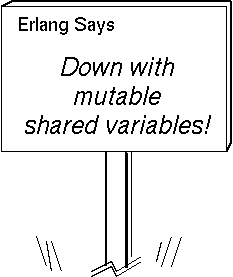
Mutable variables suffer from RaW, WaR and WaW hazards!
Using shared variables to communicate between threads is a low-level model of computation that:

CSP and Kahn-like process networks are an important model of computation based on channels. In computation theory terms, they might be viewed as a set of Turing machines connected via one-way tapes. »CSP»Kahn Process Networks»pn tool for Process Networks.
Disadvantage: deadlock is possible.
Some languges, such as Handel-C, Occam, Erlang and the best Bluespec coding styles completely ban shared variables and enforce use of CSP-like channels »(LINK: Handel-C.pdf)
Handel-C uses explicit Kahn/Occam/CSP-like channels ('!' to write, '?' to read):
// Generator (src) // Processor // Consumer (sink)
while (1) while(1) while(1)
{ { {
ch1 ! (x); ch2 ! (ch1? + 2) $display(ch2?);
x += 3; } }
}
Using channels makes concurrency explicit and allows synthesis to re-time the design.
In CSP and Kahn-like networks, all communication is via blocking read and lossless write to/from unbound FIFOs.
A variation on the basic paradigm is whether or not a reader can peek into the FIFO and make random access removal. Another variation: a chordal dequeue may typically be supported, where an atomic (pattern-matching) read of multiple input channels is made at once, as in the join calculus. Atomic write multiple is also sensible to support at the same time. A basic system based on this paradigm requires the user code in this manner and renders RTL circuits correspondingly. Each channel has some physical FIFO or one-place buffer manifestation with the handshake wires being automatically synthesised.
But advanced compilers can:
A systolic array is similar to a CSP/Kahn network, but the processing elements operate in lock-step instead of having FIFO queues between the nodes. A number of HLS compilers target systolic arrays instead of (or as well as) the classical sequencer approach. Exercise for the sheet: It is argued that the systolic array approach is superior to a Kahn network when there will be no deviations from a static schedule. Consider a matrix multiplication or CNN application: is the FIFO between nodes needed for CNN accelerators?
| 43: (C) 2012-18, DJ Greaves, University of Cambridge, Computer Laboratory. |